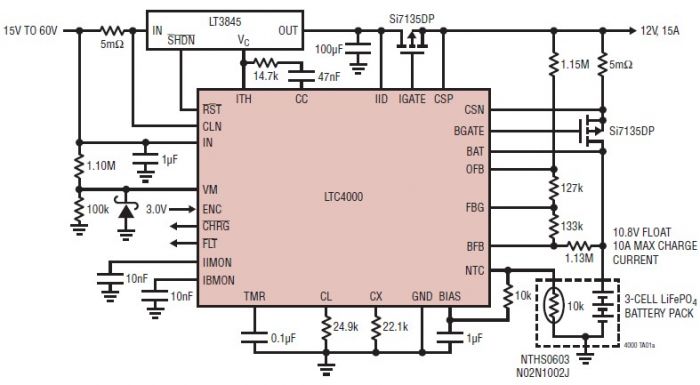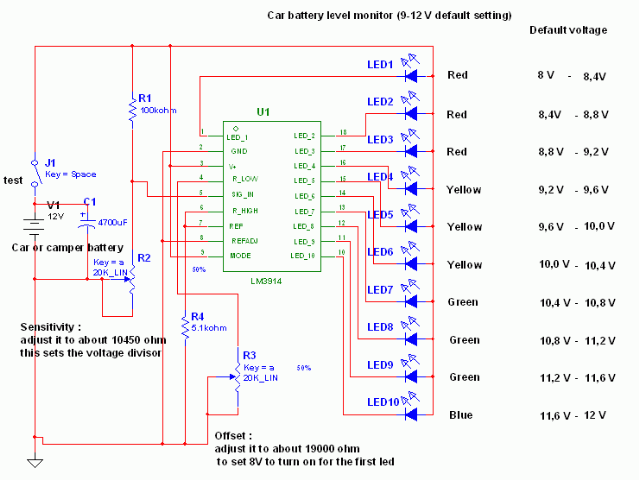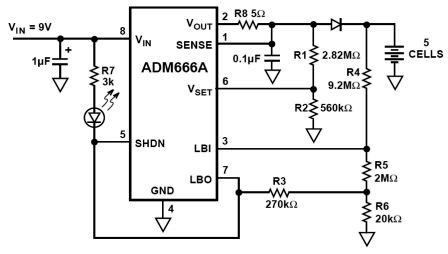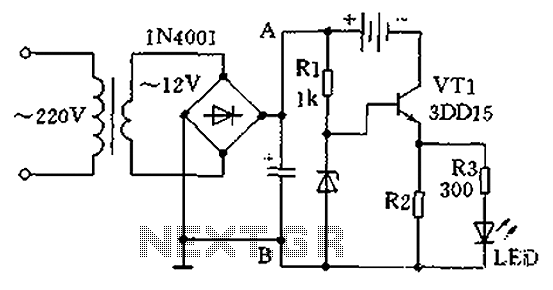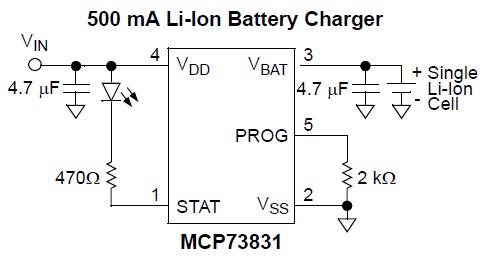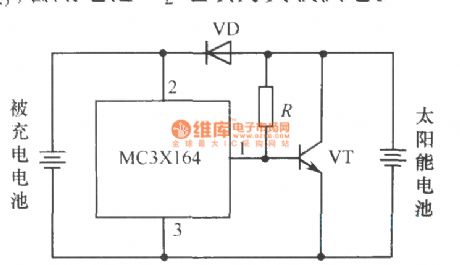
simplest smf automotive battery charger
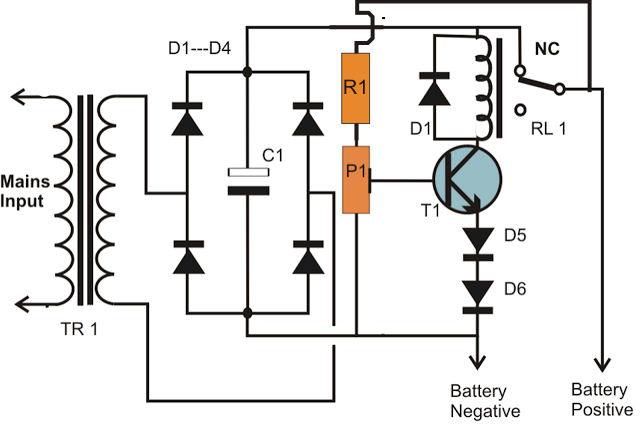
A simple battery charger circuit is described, utilizing a single transistor for voltage detection and automatically disconnecting the battery from the supply when fully charged. The circuit's high voltage trip point is set to switch off the charging voltage when the battery reaches approximately 14 volts. A general-purpose transistor, such as the BC547, is typically adjusted to switch on at 14 volts, with a lower threshold around 10 volts, which poses a risk as it is too low for safe operation. To address this issue, the circuit incorporates two diodes at the transistor's emitter to reduce the hysteresis level. This adjustment allows the transistor to switch off 1.4 volts earlier than the normal specified limit, raising the lower operating threshold to 11.4 volts. This modification ensures safe battery operation and automatic restart of the charging process, resulting in an efficient and cost-effective automotive battery charger.
The described battery charger circuit employs a single transistor, specifically the BC547, to manage the charging process of an automotive battery. The circuit is designed to automatically disconnect the battery from the power supply when it reaches a fully charged state, indicated by a voltage of approximately 14 volts. The transistor serves a dual purpose: it detects the voltage level and controls the charging state to prevent overcharging.
The critical aspect of this design is the establishment of two voltage thresholds: the upper threshold, set at 14 volts, and the lower threshold, initially around 10 volts. The lower threshold of 10 volts is problematic, as allowing the battery voltage to drop to this level risks potential damage to the battery. To mitigate this issue, the circuit incorporates two diodes in series with the emitter of the transistor. This configuration effectively modifies the lower threshold by reducing it by 1.4 volts, raising the operational threshold to a safer level of 11.4 volts.
This adjustment ensures that the battery will not be allowed to discharge to dangerously low levels before the charging process resumes. The use of diodes introduces a small voltage drop, which is essential for enhancing the overall functionality and reliability of the charger. The design is both economical and efficient, making it suitable for automotive applications where battery maintenance is crucial.
In summary, the circuit achieves a balance between cost and functionality, providing an intelligent solution for automotive battery charging. The automatic disconnection feature, combined with the improved voltage thresholds, ensures that the battery remains in optimal condition without the risk of over-discharge or overcharging, making this circuit an effective choice for battery management.A very simple battery charger circuit is described in this article, which uses just a single transistor for the voltage detection as well as for automatically disconnecting the battery from the supply when it gets fully charged. This adjustment becomes the high voltage trip point of the circuit and is used to switch OFF the charging voltage to
the battery when it gets fully charged or its voltage reaches around 14 volts. Typically a general purpose transistor like the one which is shown (BC547) when adjusted to switch ON at 14 volts may have the lower threshold of around 10 volts, when it might get just switched OFF. The lower threshold of 10 volts is dangerously low and we cannot wait for the circuit to restart the charging process until the battery voltage falls to this dangerous 10 volts level.
Therefore to eliminate this issue the circuit needed to somehow reduce the hysteresis level. This is done by introducing a couple of diodes at the emitter of the transistor. By inserting the two diodes in series with the emitter of the transistor, we force the transistor to switch off 1. 4 V earlier than its normal specified limit of 10 volts. Therefore now the lower operating threshold of the circuit becomes 10 + 1. 4 = 11. 4 volts, which may be considered just OK for the battery and for the automatic restart of the charging process.
Having both the thresholds updated as per the standard charging requirements, we now have an automatic automotive battery charger that`s not only cheap to build but also smart enough to take care of the battery charge conditions very efficiently. 🔗 External reference
The described battery charger circuit employs a single transistor, specifically the BC547, to manage the charging process of an automotive battery. The circuit is designed to automatically disconnect the battery from the power supply when it reaches a fully charged state, indicated by a voltage of approximately 14 volts. The transistor serves a dual purpose: it detects the voltage level and controls the charging state to prevent overcharging.
The critical aspect of this design is the establishment of two voltage thresholds: the upper threshold, set at 14 volts, and the lower threshold, initially around 10 volts. The lower threshold of 10 volts is problematic, as allowing the battery voltage to drop to this level risks potential damage to the battery. To mitigate this issue, the circuit incorporates two diodes in series with the emitter of the transistor. This configuration effectively modifies the lower threshold by reducing it by 1.4 volts, raising the operational threshold to a safer level of 11.4 volts.
This adjustment ensures that the battery will not be allowed to discharge to dangerously low levels before the charging process resumes. The use of diodes introduces a small voltage drop, which is essential for enhancing the overall functionality and reliability of the charger. The design is both economical and efficient, making it suitable for automotive applications where battery maintenance is crucial.
In summary, the circuit achieves a balance between cost and functionality, providing an intelligent solution for automotive battery charging. The automatic disconnection feature, combined with the improved voltage thresholds, ensures that the battery remains in optimal condition without the risk of over-discharge or overcharging, making this circuit an effective choice for battery management.A very simple battery charger circuit is described in this article, which uses just a single transistor for the voltage detection as well as for automatically disconnecting the battery from the supply when it gets fully charged. This adjustment becomes the high voltage trip point of the circuit and is used to switch OFF the charging voltage to
the battery when it gets fully charged or its voltage reaches around 14 volts. Typically a general purpose transistor like the one which is shown (BC547) when adjusted to switch ON at 14 volts may have the lower threshold of around 10 volts, when it might get just switched OFF. The lower threshold of 10 volts is dangerously low and we cannot wait for the circuit to restart the charging process until the battery voltage falls to this dangerous 10 volts level.
Therefore to eliminate this issue the circuit needed to somehow reduce the hysteresis level. This is done by introducing a couple of diodes at the emitter of the transistor. By inserting the two diodes in series with the emitter of the transistor, we force the transistor to switch off 1. 4 V earlier than its normal specified limit of 10 volts. Therefore now the lower operating threshold of the circuit becomes 10 + 1. 4 = 11. 4 volts, which may be considered just OK for the battery and for the automatic restart of the charging process.
Having both the thresholds updated as per the standard charging requirements, we now have an automatic automotive battery charger that`s not only cheap to build but also smart enough to take care of the battery charge conditions very efficiently. 🔗 External reference
